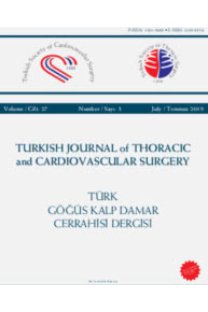First but not last: Forearm!
First but not last: Forearm!
___
- 1. Schmidli J, Widmer MK, Basile C, de Donato G, Gallieni M, Gibbons CP, et al. Editor's Choice - Vascular Access: 2018 Clinical Practice Guidelines of the European Society for Vascular Surgery (ESVS). Eur J Vasc Endovasc Surg 2018;55:757-818.
- 2. Uzun HA, Çiçek ÖF, Seren M. Transposition of basilic vein in forearm for arteriovenous fistula creation: Our mid-term results. Turk Gogus Kalp Dama 2019;27:508-11.
- ISSN: 1301-5680
- Yayın Aralığı: 4
- Başlangıç: 1991
- Yayıncı: Bayçınar Tıbbi Yayıncılık
Ahmet Barış DURUKAN, Ertuğrul ERCAN, Hakan GÖÇER, Muhammed ABUSHAREKH
Supravalvüler aort darlığında tekrarlayan cerrahi yaklaşım gereksinimi
Çağatay BİLEN, Gökmen AKKAYA, Osman Nuri TUNCER, Yüksel ATAY
Minimal invaziv akciğer kanserinde eski bir kontrendikasyon: Bronşiyal staplere yer yok
Kemal AYALP, Tuğba COŞGUN, Erkan KABA, Alper TOKER
Endovasküler anevrizma tamiri sonrası uzun dönemde akut aort trombozu: Olgu sunumu
Sinan ERKUL, Gülen Sezer ALPTEKİN ERKUL
Mitral kapak ameliyatlarında robotik yardımlı ek işlemlerin uygulanabilirliği
Mert DUMANTEPE, Muharrem KOÇYİĞİT, Şahin ŞENAY, Ahmet Ümit GÜLLÜ, Eyüp Murat ÖKTEN, Hasan KARABULUT, Cem ALHAN
Akut akciğer hasarı ve apoptozisi önlemede oleanolik asidin etkisi
Erhan AYAN, Lülüfer TAMER GÜMÜŞ, Rabia BOZDOĞAN ARPACI, Abdulkerim BAYÜLGEN, Mehmet Oğuz KÖKSEL
Behçet hastalığı olan bir olguda kaplı stent ile tedavi edilen izole brakiyal arter anevrizması
Anıl ÖZEN, Hakkı Zafer İŞCAN, Selin ÖZEN, Görkem YİĞİT
Heartmate III sol ventrikül destek cihazının outflow greft bükülmesi: Olgu sunumu
Özgür YILDIRIM, Oğuz KONUKOĞLU, Denyan MANSUROĞLU, Shiraslan BAKSHALİYEV, Kenan SEVER, Mehmet BALKANAY
Sternal kleft malformasyonunun cerrahi onarımı
Rıza Doğan, Ulaş Kumbasar, Benan Bayrakçı, Serkan Uysal, Selman Kesici
